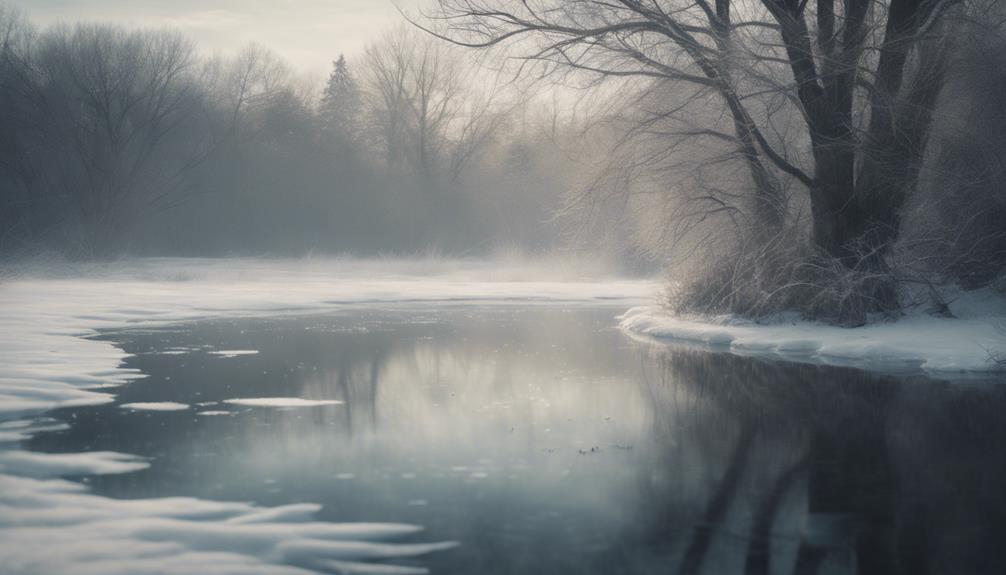You'll want to install an aeration system before winter sets in to prevent fish kills under the ice. This system maintains oxygen levels and circulates water, stopping fall turnover and fish kills. Running the aeration system 24/7 during winter prevents ice buildup in the pump chamber, keeping it functional and efficient. This approach also increases beneficial aerobic bacteria, giving you a head start on algae control for the next spring. By focusing on winter aeration essentials, you'll safeguard the health and well-being of your aquatic ecosystem. Now, learn how to tailor your system to your pond's unique needs and guarantee a thriving environment.
Table of Contents
Key Takeaways
- Install an aeration system before ground freezing to prevent fish kills under ice and guarantee effective winterization.
- A well-designed aeration system maintains oxygen levels, circulates water, and prevents fall turnover and fish kills during winter.
- Regular maintenance and inspections are crucial during winter to prevent ice blockages and ensure proper function of the aeration system.
- Running the aeration system 24/7 during winter prevents ice buildup in the pump chamber, keeping the fountain functional and efficient.
- Aeration systems increase beneficial aerobic bacteria, giving a head start on algae control for the next spring.
Preparing for Winter Months
As you prepare your pond for the upcoming winter months, it's essential to install an aeration system before the ground freezes to prevent fish kills under ice and guarantee effective winterization.
By doing so, you'll safeguard that your pond remains healthy and thriving throughout the cold season. A Winter Pond Aeration system is necessary for maintaining oxygen levels and circulating water, which is pivotal for preventing fall turnover and fish kills.
Additionally, a Pond Aerator helps to increase the presence of beneficial aerobic bacteria, giving you a head start on algae control for the next spring.
By running your aeration system 24/7 during the winter, you'll prevent ice buildup in the pump chamber, safeguarding that your fountain remains functional and efficient.
Regular maintenance and inspections are also pivotal during winter to prevent ice blockages and safeguard proper function of the aeration system.
Aeration System Essentials
You'll need to weigh several critical components when selecting an aeration system for your pond, including its ability to improve gas exchange, limit algae growth, and withstand freezing temperatures.
A well-designed aeration system is essential for maintaining a healthy pond ecosystem, especially during the winter months. By improving gas exchange, your aeration system will increase oxygen levels, reducing the likelihood of toxic gas buildup. This is vital, as low oxygen levels can lead to stress and even death in aquatic life.
Regular aeration will also help reduce algae growth, promoting a balanced ecosystem.
An aeration system can be used year-round, including during winter, to keep water temperatures stable and prevent freezing. By combining a de-icer and pond aeration kit, you'll guarantee a hole remains open in the ice, maintaining high dissolved oxygen levels and promoting water circulation.
This will create a healthy environment for your pond's inhabitants, even in the coldest of temperatures. By selecting the right aeration system for your pond, you'll be well on your way to a thriving and balanced ecosystem.
Winter Pond Maintenance Tips

As you prepare your pond for the cold winter months, making it crucial to prioritize winter aeration essentials and create a pond maintenance checklist to safeguard the health and well-being of your aquatic ecosystem.
By focusing on these critical aspects, you'll be able to maintain a balanced and thriving environment for your fish and plants.
In the following sections, we'll explore the key elements of winter aeration and provide an exhaustive checklist for your pond's winter maintenance.
Winter Aeration Essentials
To guarantee your pond's ecosystem remains healthy and thriving during the harsh winter months, maintaining a well-functioning aeration system is essential, as it plays a pivotal role in preventing winter fish kill and toxic gas buildup. You'll want to verify your aeration system is running smoothly to keep oxygen levels up and prevent harmful gases from forming.
| Task | Frequency | Importance |
|---|---|---|
| Clean filters | Every 3-6 months | Vital for peak performance |
| Inspect compressor | Every 3-6 months | Prevents damage and guarantees safety |
| Check for ice blockages | Regularly | Prevents system failure and guarantees proper function |
Pond Maintenance Checklist
Having confirmed your aeration system is running smoothly, focus on tackling the broader winter pond maintenance tasks to guarantee a healthy ecosystem.
As a responsible pond owner, you understand the importance of pond management during the winter months. Regular maintenance is vital to maintaining prime water quality and ensuring a thriving ecosystem.
Remove debris and sediment: Regularly remove fallen leaves, branches, and sediment from the pond floor to prevent decay and maintain water clarity.
Monitor water levels: Keep an eye on water levels, as they can fluctuate greatly during the winter months due to evaporation and precipitation.
Check for ice formation: Regularly inspect your pond for ice formation, which can lead to oxygen depletion and harm aquatic life.
Perform partial water changes: Perform partial water changes (10-20% every 4-6 weeks) to maintain prime water quality and prevent the buildup of toxins.
Combining De-Icer and Aerator
By combining a de-icer and aeration kit, you can create a safe and healthy environment for your fish and aquatic plants during the harsh winter months. This powerful duo guarantees a hole remains open in the ice, promoting water circulation and maintaining high dissolved oxygen levels. The de-icer maintains an open hole in the ice for gas exchange, while the aeration kit infuses oxygen into the water through air stones or diffuser sticks, promoting gas exchange and reducing algae growth.
| Benefits | De-Icer | Aeration Kit |
|---|---|---|
| Maintains open hole in ice | ||
| Promotes gas exchange | ||
| Reduces algae growth |
Choosing the Right Aerator

When selecting an aerator for your pond, consider the specific needs of your aquatic environment, taking into account the pond's size, shape, and depth, as well as the type of aquatic life it supports. This will guarantee you provide the right amount of oxygen for a healthy ecosystem.
With the right aerator, you can enjoy a thriving pond year-round.
Customization: Aeration kits can be tailored to suit your pond's unique needs, securing peak oxygen levels and water circulation.
Cost-effective: Aeration systems have a lower operating cost than pumps, with some systems costing as low as $0.20 per month to operate.
Year-round use: Aeration kits can be used during winter and other cold months, keeping your pond healthy and thriving.
Combination benefits: De-icers and aeration kits can be combined to maintain open water, promote circulation, and prevent toxic gas buildup.
Winterizing Your Fountain
When winterizing your fountain, you'll need to remove and store it properly to prevent damage from freezing temperatures.
You'll want to follow specific tips to guarantee a safe and successful removal, and then store it in a way that protects it from the elements.
Fountain Removal Tips
During the winterization process, you'll need to disconnect and drain your fountain to prevent ice damage and bacterial growth. This is a vital step to safeguard your fountain remains in good condition until the warmer months return.
Turn off the power: Switch off the fountain's electrical supply to prevent any accidental startups.
Drain the water: Use a pump or let gravity do its job to remove as much water as possible from the fountain and its pipes.
Clean the fountain: Give your fountain a good scrub to remove any dirt, debris, or algae that may have accumulated.
Dry the components: Use a soft cloth to dry the fountain's components, including the pump, pipes, and other parts, to prevent water spots and corrosion.
Fountain Storage Methods
You'll need to choose a suitable storage method for your fountain to protect it from harsh winter conditions and potential damage.
Fountain storage methods vary, but a common approach is to disassemble and clean the fountain, then store it in a dry, protected area.
Remove any electrical components, such as pumps and lights, and store them separately in a dry location.
If you can't disassemble your fountain, consider wrapping it in a waterproof cover or tarp to shield it from the elements.
When storing your fountain, keep a hole in the cover to allow air to circulate and prevent moisture buildup.
This will help prevent damage from freezing temperatures.
If you have a bottom diffused aeration system, make sure to store it in a way that allows it to drain completely, as trapped water can cause damage.
Proper storage will help guarantee your fountain remains in good condition until spring, when you can reinstall it and enjoy it once again.
Winter Maintenance Checks
Now that your fountain is safely stored, inspect it for any damage or wear that may have occurred during the previous season, and make a list of any repairs or maintenance tasks you need to tackle before reinstalling it in the spring.
This is a vital step in winterizing your fountain, as neglecting maintenance can lead to costly repairs or even toxic gases building up in your pond.
Clean the pump and filters: Remove any debris or sediment that may have accumulated during the season.
Inspect the aeration system: Verify that all components are functioning properly and make any necessary adjustments.
Check for leaks and cracks: Inspect the fountain's pipes and fixtures for any signs of damage or wear.
Perform a system flush: Drain and refill the system to remove any built-up contaminants.
Frequently Asked Questions
Should I Leave My Pond Aerator on in the Winter?
When deciding whether to leave your pond aerator on in winter, you'll want to weigh ice formation risks against energy efficiency concerns and maintenance schedule impacts, as continuous operation can be beneficial but also costly and potentially damaging.
Will a Pond Aerator Keep Water From Freezing?
You might think a pond aerator can completely prevent ice formation, but it won't; instead, it'll help mitigate frost damage and maintain water circulation, reducing the risk of winter fish kills, but not keeping the entire surface from freezing.
How Do You Oxygenate a Pond in the Winter?
You've wondered if oxygenating a pond in winter is a myth, but it's vital for winter fish care. You can prevent ice formation and promote cold water circulation by using a winter pond aeration kit with air stones or diffuser sticks.
How Long Do Pond Aerator Pumps Last?
You can expect your pond aerator pump to last 5-10 years or more with proper maintenance, which includes regular cleaning and inspections to guarantee energy efficiency, and be prepared to replace it eventually, considering the replacement cost.
Conclusion
You've taken the right steps to winterize your pond, and now you can rest assured your aquatic ecosystem will thrive even in the coldest months.
Did you know that a well-maintained aeration system can increase oxygen levels by up to 30%, reducing winter fish kills and keeping your pond healthy?
By following these guidelines, you'll be well on your way to a successful winterization process, and your pond will emerge in the spring stronger than ever.

